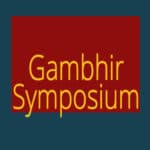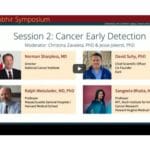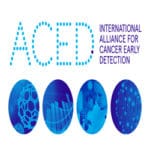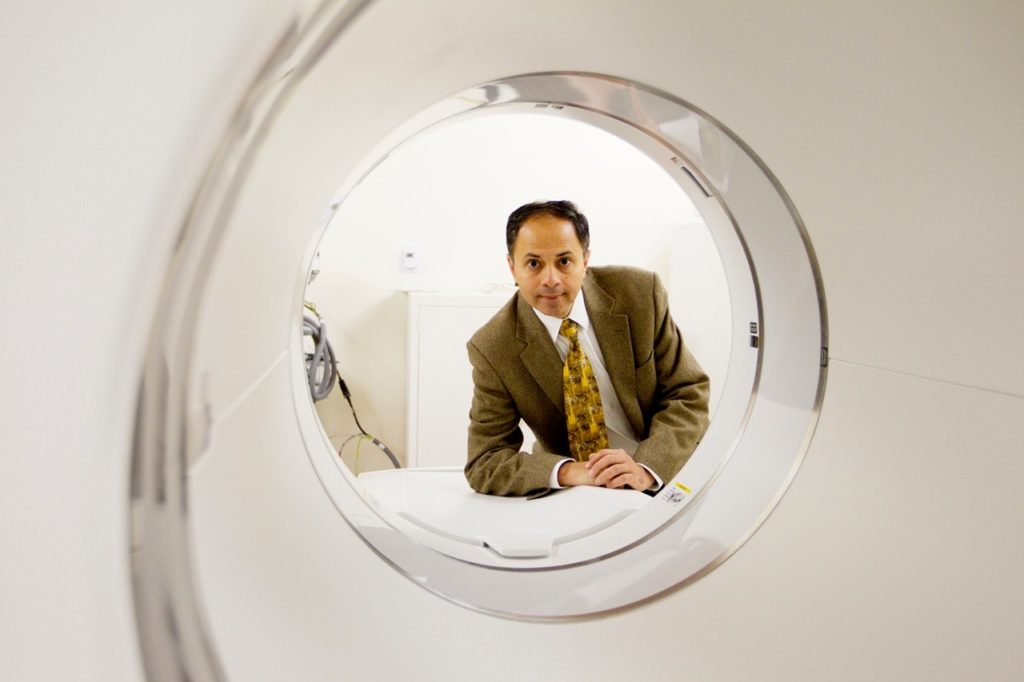Blog
Posts Tagged ‘Cancer’
Don Listwin Award For Outstanding Contribution to Cancer Early Detection 2022 goes to: Sudhir Srivastava, Ph.D., MPH, MS
November 16, 2022

The Don Listwin Award for Outstanding Contribution to Cancer Early Detection recognizes a sustained contribution to, or singular achievement in, the cancer early detection field.
The 2022 Award goes to: Sudhir Srivastava, Ph.D., MPH, MS: Senior Scientific Officer and Chief of the Cancer Biomarkers Research Branch in the Division of Cancer Prevention, National Cancer Institute (NCI), National Institutes of Health (NIH).
He is well-known for having established a number of transformative programs on translational research on cancer screening, early detection, risk assessment and enabling technologies including artificial intelligence with a network of leading experts in medicine, science, computational biology that has advanced scientific discoveries and revolutionized diagnostics in cancer early detection.
In 2000, Dr. Srivastava developed and implemented a novel approach to collaborative clinical research on cancer biomarkers through the establishment of the Early Detection Research Network, a flagship program at the NCI that has begun translating biomarkers into clinical tests (> 8 FDA approved and > 19 CLIA certified) for early detection. This network has been a pioneer in applying innovative technologies in the validation of cancer biomarkers as well as in the development of a national informatics infrastructure to support the research.
He also developed a number of strategic programs that promotes the convergence of interdisciplinary approaches from physics, biology, chemistry, and engineering emphasizing seamless integration of these disciplines into innovations, team science and translation from the bench to the bedside. These include EDRN, the Alliance of Glycobiologists, the Liver Cancer Consortium, the Liquid Biology Consortium, the Pancreatic Cancer Early Detection Consortium, the Cancer Imaging and Biomarkers Program, and the PreCancer Atlas. His conceptualization and implementation of the EDRN informatics infrastructure, in collaboration with NASA’s Jet Propulsion Laboratory, has become a model for similar collaboration established at the NIH. He is respected as an early adapter of emerging technologies, in particular, artificial intelligence initiatives he launched in 1994, before the science became omnipresence in the life sciences and a vital approach in today’s world of enhancing human capabilities. He has successfully developed partnerships on shared interests with the National Institute of Standards and Technology, DOD’s Center for Prostate Disease Research, DOE’s Pacific Northwest National Laboratory, and the Jet Propulsion Laboratory. In addition, he has developed collaborations with international and non-profit foundations, such as Japan’s Agency for Medical Development and Research, Cancer Research-UK, the China Cancer Institute/Chinese Academy of Medical Sciences, and U.S. organization such as Pancreatic Cancer Action Network, Lustgarten Foundation, and Kenner’s Family Research Foundation.
In recognition of his leadership in cancer diagnostics, Dr. Srivastava was featured in Wired magazine in August 2003, and more recently, has been awarded a Distinguished Public Service Award (2016) by the American Pancreatology Association, a Distinguished Clinical and Translational Proteomics Award (2017) by HUPO International, and the Distinguished NCI Cancer Prevention Fellowship Program (CPFP) Alumni Award (2016).
* Excerpt taken from https://www.earlydetectionresearch.com/award/
Don Listwin Award For Outstanding Contribution to Cancer Early Detection 2021 goes to Rebecca Fitzgerald, MD, FMedSci
October 11, 2021

The Don Listwin Award for Outstanding Contribution to Cancer Early Detection recognizes a sustained contribution to, or singular achievement in, the cancer early detection field.
The 2021 Award goes to: Rebecca Fitzgerald MD FMedSci, MRC Cancer Unit, University of Cambridge and an internationally recognized pioneer for her exceptional research into the prevention and detection of oesophageal cancers.
This award was announced at the recent Early Detection of Cancer Conference – EDx21.
This award is given to recognize and thank Rebecca for the work she has done to develop, grow and establish the research needed to detect cancer early.
She is the Interim Director of the MRC Cancer Unit, Hutchison-MRC Research Centre, Professor of Cancer Prevention, and Clinician Scientist leading research in the Early Detection of Cancer for the University of Cambridge and the CRUK Alliance for Cancer Early Detection (ACED). Rebecca is known for the development of the Cytosponge technology, a sponge on a string that patients can swallow instead of undergoing an endoscopy. The Cytosponge collects cells from the oesophagus for staining, which can flag the presence of TFF3-positive cells indicative of Barrett’s oesophagus, a precursor to oesophageal cancer. Recently Rebecca and her team published work demonstrating that Cytosponge increases the identification of Barrett’s in individuals with frequent heart-burn symptoms by 10-fold compared to standard of care. The building of evidence for its clinical implementation for surveillance of high-risk individuals and in endoscopy sparing due to COVID-19 related pressures on health systems continues to make a vital impact to patients’ lives and is internationally recognized for its contribution towards breaking barriers in research.
Congratulations to Rebecca and we are pleased to have her within the early detection community.
The 2021 Gambhir Symposium (virtual) –celebrating ongoing work of visionary and pioneer Dr. Sanjiv Sam Gambhir
August 6, 2021

The 2021 Gambhir Symposium (virtual) held on July 19, 2021 included discussions and presentations celebrating the continuing work on paths forged by Sanjiv Sam Gambhir, MD, PhD, (1962-2020) in the fields in which he launched new directions:
Molecular Imaging, Cancer Early Detection, Precision Health.
Click Here to see the Conference Agenda & Videos.

Click here to see the videos from the Cancer Early Detection Session.
Canary’s International Collaboration – ACED
March 8, 2021

The International Alliance for Cancer Early Detection (ACED) joins researchers from the United States and the United Kingdom in a $70 million partnership. Founded in 2019, ACED is a partnership with the Canary Center at Stanford University, CRUK, the University of Cambridge, the Knight Cancer Institute at Oregon Health and Science University (OHSU), University College London and the University of Manchester. The following is one study chosen for it’s innovative approach to early detection:
Stratifying Risk for Early Detection in Hereditary Breast and Ovarian cancer
Project Award, led by: Marc Tischkowitz, University of Cambridge; Allison Kurian, Canary Center at Stanford for Cancer Early Detection; and Gareth Evans, University of Manchester. Stanford Team: Allison Kurian, Alice Fan, James Ford
CanRisk is a cancer risk assessment tool which combines genetic, lifestyle, clinical and imaging data to calculate an individual risk estimate for women with high-risk mutations in BRCA1 and BRCA2. The ability to provide personalized cancer risk estimates will identify women at particularly high risk. Currently, the ranges of cancer risk estimates for women with hereditary mutations in breast cancer genes are wide and not personalized, so all women are given the same figures. Creating a customized approach can solve this problem.
By implementing personalized risk estimates, early detection strategies can be tailored for the individual, therefore identifying those at the highest risk. Once feasibility is assessed, women undergoing predictive testing for BRCA1, BRCA2, PALB2, ATM or CHEK2 in US and UK genetics centers will be randomized to conventional vs personalized risk estimate based on genetic/lifestyle/hormonal modifiers.
Our ovarian cancer team continues to build infrastructure for innovative pilot study and biobank.
October 7, 2020
The Ovarian team has used these past months to hone and polish the infrastructure for the High Grade Serous Ovarian Cancer Initiative and to ensure that high quality molecular data can be generated from the samples. This includes both the pilot project that focuses on changes in the micro-environment, and the retrospective study that looks back at tissue.
Focus of the project
Our focus is to define the role of the fallopian tube micro-environment in the development of high grade serous ovarian cancer (fallopian tube being the most common ovarian cancer), with the ultimate objective to find targets for prevention and markers of early disease onset for early detection.
Convening experts
In order to develop a robust and innovative research plan, we invited a multidisciplinary team of roughly 25 world class ovarian cancer researchers from across the US and Canada to an initial two day planning meeting in March 2019 in Los Gatos, California. The meeting was highly successful. The number of promising ideas exceeded our available funding level. Over the ensuing months the Executive Committee worked to refine and finalize our research proposal and also put in place the necessary infrastructure to conduct our studies.
What problem is the team trying to solve? Our overall plan includes a series of innovate pilot studies specifically designed to demonstrate the power of our team and generate preliminary data that can be leveraged to compete for large grants by the end of a two year period. The research will be performed in two phases: first, a retrospective phase that involves analysis of previously collected, banked fallopian tube samples with associated clinical information, and second, a prospective study, that includes newly collected samples, each with the goal of identifying what changes in the molecular landscape signal cancer.
Our progress March – Summer 2020. During these past months, the team has finalized the infrastructure for the pilot program and has worked to ensure that the expected high quality molecular data from our samples can be achieved. The process for sample sharing has been completed. Additionally, reviews, discussions, and decisions have been held to work out a draft of the high-quality protocol necessary for all team members to follow. 6 potential sites have been identified. We are testing our data management processes. This includes a portal for sharing and annotating data among multiple investigators and analysts. Canary Foundation has experience in this field.
Next steps: the in-person clinical aspect of the pilot will resume when each of the participating sites are reopened. When further steps in reopening allow, clinical sites will be responsible for providing patient samples and annotated clinical and pathologic data in a timely and cost-effective way. Each site includes a collaborative PI who has a robust system in place for conducting translational research studies, banking samples and linking clinical information.
Additionally, steps are being taken to identify and put in place a central project manager. An interim plan is in place utilizing resources at the University of Pennsylvania.
Organizational Structure
Clinical data and sample coordination center: The University of Pennsylvania leader is Michael Feldman. We are working with the team at UPenn to write sample protocols and requirements and to finalize the overall collaboration agreement that will be signed by all institutions. The coordinating center will receive samples from clinical sites, perform quality control, and prepare and ship samples to molecular profiling sites. The center will also maintain the clinical database of participants linked to their sample information. The clinical data will be linked later to the molecular data for each of the samples and participants.
Clinical teams: when further steps in reopening allow, clinical sites will be responsible for providing patient samples and annotated clinical and pathologic data in a timely and cost-effective way.
Molecular profiling sites: Molecular analyses will include bulk RNA and DNA sequencing, global methylome profiling, proteomics with spatial profiling, single cell analyses using the Nanostring DSP platforms.
Data management and analysis center: We have multiple types of data that need to be securely stored and annotated. We are using a similar structure to that used by the large NIH-funded effort, TCGA. Raw data will be hosted in the data center managed by Adam Olshen at UCSF. We will run data analysis pipelines and upload processed data into a program that will function as a portal for sharing and annotating data among multiple investigators and analysts. Canary Foundation has experience in this field.
Shaping bioinformatics. Our leadership and analysis team leaders are enthusiastic about working together using Synapse and the Sage engineers. The associated infrastructure and analysis plan from our bioinformaticians Adam Olshen (UCSF) and
Hui Shen (Van Andel) has been reviewed and approved by the group.
Checking our system.
- Testing of infrastructure and logistics with a small set of samples will include:
- Assessing technical issues
- Management of resources
- Rapid course correction procedures
- Generating first data set
- Send samples through the pipeline (10 BRCA mutation carriers)
- Check quality control measures on data set
Working as a team. Part of the strategy is to demonstrate our ability to work together and generate data so that we are able to apply for additional support from external agencies (e.g. government or foundations). The team is actively making connections to seek out the best funding opportunities as part of our future plan, and the breadth of expertise in the team and their ability to work well together go a long way in securing future funding.
Remembering Sanjiv Sam Gambhir, MD, PhD, Stanford University Radiology Chair, Director of the Canary Center at Stanford for Cancer Early Detection
August 4, 2020
Sam’s image: forever in our hearts.
 November 23, 1962 – July 18, 2020
November 23, 1962 – July 18, 2020
“The body is a mystery.” This is something you don’t expect to hear from a distinguished worldwide leading expert in radiology, who developed cutting edge imaging tests to spot disease early inside the body using new and repurposed technologies in highly innovative ways. You would think such a person would tout how much we do know. And yet, this is exactly what we would hear from our good friend and guide Sanjiv Sam Gambhir. He believed that the reason cancer seemed to take so many different characteristics in each individual person was because we know so little about the body. It was times like this you would be moved by just how humble Sam was. Add to that just how important Sam has been to Canary Foundation’s mission, and you understand why we will miss him as a beloved partner and visionary for cancer early detection.
We met Sam during the first year Don Listwin founded Canary Foundation in 2004. Don had lost his mother several years before to misdiagnosed ovarian cancer and had decided to use his time and resources to try to impact the common problem of misdiagnosis. Don and cancer research Nobel Laureate Lee Hartwell had earlier conversations about cancer being an engineering problem, where answers were out there but not being brought together to sensible resolution. Canary Foundation went on to develop multi-institutional, multi-disciplined teams providing them with start-up funds to work together towards common goals. They then gather enough results to attract further funding from larger grantors and the government.
Sam filled a vital role in the “workflow” as an imaging expert, and much more. He helped solidify our mission to develop tests to curb cancer deaths by finding tumors early, then isolating their location through imaging, followed by removal or targeted treatment. He quickly became the leader of the science teams using his expert skills in convening the lead researchers in the field.
What was it about Sam that made his complex science and vision understandable? Sam was relaxed as he described a full and brilliant universe of information, knowing exactly what metaphors to use to get his ideas across. For instance, Sam eagerly described his work in imaging as using “molecular spies” that could sleuth out cancer tumors, then send back a signal that greatly enhanced a physician’s ability to “spot” the cancer in the imaging.
Sam laughed easily and liked to poke good humored fun at his colleagues. He was mild mannered and didn’t jockey for the spotlight as one with his level of mastery might. He liked pop music and was genuinely interested in what you had to say. While none of this is written in leadership training books, it all worked well in moving the science forward.
In 2008, Canary Foundation and Stanford University signed partnership papers that sealed the deal on an agreement where both institutions would bring resources to create the Canary Center at Stanford for Cancer Early Detection. Sam led Stanford and kept his eye on the potential that would become the first worldwide center focused on cancer early detection. The Canary Center opened doors in 2009 and would grow to attract world-class researchers. We have accomplished much with Sam at our side. Canary Foundation has since mentored those working on opening international centers at Cambridge United Kingdom and the University of Calgary, Canada. Our annual symposium, the first of its kind that attracted young and seasoned researchers to a collaborative forum, has become, with Sam’s help, a prestigious multi-institutional event now organized by national and global partners.
Sam’s big strategy, like Canary Foundation’s, has always been to mentor both new and seasoned scientists. His lab and the Canary Center have been a dynamic place of productivity, exchange, energy and solution-based translational research. The seeds of his work will continue to grow and flourish by those he has taught and inspired.
Sam has been an extraordinary partner. “It is amazing what you can accomplish through collaboration,” Sam said just last September at the Early Detection of Cancer Conference. We wholeheartedly agree.
All of this is to say, Sam has been a good friend to Canary Foundation and a visionary of a bright future for helping those with a cancer diagnosis.
The world will not be the same without him.
Canary Foundation
Canary’s new: High Grade Serous Ovarian Cancer Initiative. HGSOC is the most common and lethal form of ovarian cancer.
February 4, 2020
Ovarian cancer remains the most lethal gynecologic malignancy in the United States. In 2018, over 22,000 new cases were diagnosed and 14,000 women lost their lives to the disease.
Ovarian cancer is made up of distinct subtypes. High grade serous ovarian carcinoma is 70% of cases, and is the most lethal subtype accounting for over 60% of ovarian cancer deaths.
People who have inherited mutations in BRCA genes are at higher risk for certain types of cancer, including HGSOC. In looking very carefully at the fallopian tubes removed from BRCA mutation carriers, the discovery was made that the fallopian tube was a site of origin for HGSOC – not the ovary itself, but the fallopian tube. This understanding over the past 15 years represents a paradigm shift in the origin of the HGSOC and opportunity for us to better understand how the cancer develops and design better strategies for early detection and prevention.
80% of HGSOC are diagnosed at a late stage!
We want to eliminate deaths from HGSOC by early detection and prevention.
There are currently no effective methods for early detection for ovarian cancer. Substantial progress has been made in identifying the putative precursor lesions for ovarian cancers.
Our focus is to define the role of the fallopian tube microenvironment in the development of high grade serous ovarian cancer, with the ultimate objective to find targets for prevention and markers of early disease onset for early detection. We are tackling the problem from multiple directions to ensure the greatest probability of success.
It is unclear which precursor lesions are likely to progress and/or be associated with invasive disease. A critical knowledge gap is how the various constituents of the fallopian tube microenvironment impact tumor development or progression.
Achieving our goals requires a multi-institutional, multi-disciplinary effort. The team we assembled is made up of gynecologic oncologists, molecular biologists, epidemiologists, pathologists and bioinformaticians. The team is world class and has the requisite expertise to capitalize on complementary molecular profiling. Our research plan leverages powerful, broad-based discovery approaches to tackle this difficult challenge of early detection.
Dr. Heidi Aumen explains more:
Canary’s Prostate Active Surveillance Study (PASS) receives $6.7M NCI grant to support growth of the multi-center study!
December 2, 2019
PASS was established in 2008 with funding from the Canary Foundation, demonstrating how we invest in promising early research!
“PASS was launched with six participating centers in 2008,” said PASS Deputy Director Dr. Lisa Newcomb, a Hutch cancer prevention researcher. “With this grant, we’ll be up to 11 sites. Fred Hutch is the centralized repository — specimens are sent to the Hutch from all the sites — and we have procedures for sharing the data and the specimens among the group [members] and with other researchers.”
The grant is designed to support the infrastructure of the PASS cohort, including the collection of follow-up data, management of the database and management of the biospecimen repository.
PASS participants are all early-stage prostate cancer patients who chose active surveillance, not immediate surgery or radiation, to manage their cancer. In active surveillance, patients receive regular PSA (prostate-specific antigen) testing, biopsies and digital-rectal exams to monitor whether the cancer grows or becomes more aggressive.
According to research, more than 30% of men have slow-growing prostate cancer and won’t necessarily benefit from radical treatments that can cause debilitating side effects such as urinary incontinence and impotence. Data from patients with early-stage prostate cancers who choose active surveillance can provide key insights into who’s most at risk from their cancers, and when.
Using the cohort for risk-prediction modeling, Newcomb said, could help “determine who either harbors or will progress to a bad cancer, which cancers are aggressive and which really aren’t.”
“We want to help identify the men who can go home and not worry about their cancer. We’re looking at both ends of the spectrum — making active surveillance less active and identifying the people who will benefit from treatment early.” – Dr. Lisa Newcomb
“We are thrilled,” said Newcomb regarding the transition from Canary Foundation support to NCI funding.
Fred Hutch has had a longstanding relationship with the Canary Foundation and has been the recipient of many grants from the foundation powering work in early detection. The fifth floor of Fred Hutch’s Arnold Building, home to its Public Health Sciences Division, is named for the foundation.
At present, participating sites for PASS include the University of California, San Francisco; Stanford University; Emory University; Beth Israel Deaconess Medical Center/Harvard Medical School; University of Michigan; University of Texas Health Science Center, San Antonio; Eastern Virginia Medical School; Veterans Affairs Puget Sound Health Care System; University of Washington and University of British Columbia.
Interested in PASS? Contact Dr. Lisa Newcomb or go to https://canarypass.org/
Interested in accessing Canary PASS Active Surveillance Risk Calculators? The PASS Risk Calculators provide estimates of how likely a man is to have more aggressive cancer in the future. These tools are intended to be useful for clinicians and their patients as they determine optimal methods of active surveillance. Access the risk calculators: https://canarypass.org/pass-risk-calculator/
To read the full article by Diane Mapes, a staff writer at Fred Hutchinson Cancer Research Center, please go to: https://www.fredhutch.org/en/news/center-news/2019/11/prostate-cancer-study-nci-funding-grant.html
Microbubble Imaging for Cancer Early Detection: Don Listwin Talks the Latest Technology
January 16, 2013
During our annual Ladies’ Luncheon “You’ve Got a Date with the Valley Girl” on February 8th, Jesse Draper, Don Listwin and Sam Gambhir will focus their conversation on microbubble imaging technology. Sound complicated? Watch this short video where Don explains microbubble technology and how it could radically change the way we detect cancer and stop it at the earliest possible stage. We hope you’ll be able to join us!
You’ve Got a Date with the Valley Girl: Let’s Talk Cancer Early Detection
January 15, 2013
 Every year, Canary Foundation hosts a Ladies’ Luncheon, where we discuss our most cutting edge research on cancer early detection, and discuss its implementation. This year, our luncheon “You’ve Got a Date with the Valley Girl,” will be on February 8th, and will be hosted by Jesse Draper, creator and host of “The Valley Girl Show” where she interviews start up executives and innovators. She runs the technology blog Lalawag.com and is a regular featured writer for the Mashable, San Francisco Chronicle, Huffington Post and Glam.
Every year, Canary Foundation hosts a Ladies’ Luncheon, where we discuss our most cutting edge research on cancer early detection, and discuss its implementation. This year, our luncheon “You’ve Got a Date with the Valley Girl,” will be on February 8th, and will be hosted by Jesse Draper, creator and host of “The Valley Girl Show” where she interviews start up executives and innovators. She runs the technology blog Lalawag.com and is a regular featured writer for the Mashable, San Francisco Chronicle, Huffington Post and Glam.
Save the date and plan to sit in as Jesse interviews Sanjiv (Sam) Gambhir, MD, PhD, Chair of Radiology at Stanford University, Director of the Canary Center at Stanford and Don Listwin, Founder and Chairman of the Canary Foundation.
Check out the video below to see Don invite you to join us for this fabulous annual luncheon!
